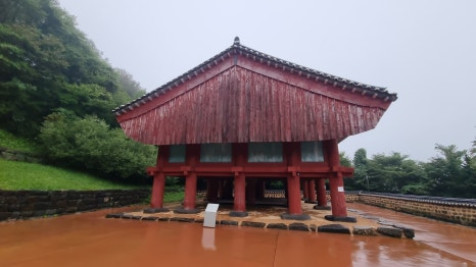Exploring Muju: A Journey Through History, Wine, and Fireflies

This post was written as part of a supporter program.
I visited Muju, a highly satisfying destination, for the Firefly Festival via a Romance Tour. Our itinerary included the Jeoksangsan Archives, the Morae Wine Cave, the Kim Hwan-tae Literary Museum, and the Choi Buk Art Museum.
We departed from City Hall Station, passed by Seoul Nat'l Univ. of Education Station and the Jukjeon Express Bus Stop, and arrived in Muju. Our schedule included visits to the Jeoksangsan Archives, the Morae Wine Cave, the Muju Firefly Festival, the Kim Hwan-tae Literary Museum, and the Choi Buk Art Museum.
The Jeoksangsan Archives, where the Annals of the Joseon Dynasty were stored, was a first-time visit for me. The rainy and foggy scenery created a mystical atmosphere, making it even more impressive!

Although it started as a rainy day, the sun began to shine from the festival grounds, allowing us to experience various weather conditions.
The festival offered amazing sights, activities, and food that captivated my senses!
I enjoyed a 1,000 won noodle dish, free Cheonma ice cream, and even witnessed the re-enactment of the Royal Annals relocation procession.
We boarded the bus at City Hall Station at 6:30 AM, stopped at Seoul Nat'l Univ. of Education Station and the Jukjeon Express Bus Stop, and then headed to Muju. The limousine bus was comfortable and pleasant!
The USB charging port was useful for me, as I tend to take many photos and videos, which quickly drains my battery.
The Jeoksangsan Archives are two buildings inside the Jeoksangsan Fortress used to store the Annals of the Joseon Dynasty.
After the Imjin War, when all but the Jeonju Archives were destroyed by fire, three more copies of the Annals from Taejo to Myeongjong were printed. These, along with the original Jeonju edition and corrected printed versions, were combined to create five copies, which were stored in Chunchugwan, Manisan, Taebaeksan, Myohyangsan, and Odaesan.
In 1641 (the 19th year of King Injo's reign), Seonwonjeon was built here to house the Seonwonrok, which officially established Jeoksangsan Archives as a complete archive.

The Jeoksangsan Archives held the Annals of the Joseon Dynasty from Taejo to Cheoljong.
The site also features a re-enactment of the Iean procession, a ceremony to relocate and store the Annals.
The Muju Morae Wine Cave was originally a tunnel used during the construction of the Muju Pumped Storage Power Plant.
In 2007, Muju County leased and remodeled the tunnel to give hope and pride to the mountain grape farmers. Now, it serves as the best wine cellar, blocking light and maintaining a constant temperature!
They make, age, store, and sell wine using the mountain grapes of Muju, providing a special experience for visitors.
Wine foot baths, which relax the body and mind, are very popular among travelers.

Morae Wine Foot Bath Experience Information:
Operating Hours:
Entry from 10:00 AM to 11:40 AM
Inspection Time: 12:00 PM - 1:00 PM
Last Entry: 1:00 PM to 4:40 PM
Separate Fee:
Adults: 3,000 won / Preschool Children: 2,500 won
Triple Effect:
Firms the skin
Promotes blood circulation, easing foot fatigue
Purifies the mind and body
The Muju Firefly Festival is where summer shines brightest in Muju!
The Muju Firefly Festival, held in a pristine natural environment, revolves around the special theme of 'fireflies'. It is a leading ecological and environmental festival in Korea, where the whole family can enjoy diverse performances, experiences, exhibitions, and local food, including a 'Mystery Exploration' where you can meet fireflies in person.

You can only enjoy the 1,000-won noodles at the food market during the festival. It’s filling and delicious!
Sampling ginseng candy and free Cheonma soft ice cream

Firefly Theme Pavilion
I took a photo inside the festival grounds and received a gift.
The Kim Hwan-tae Literary Museum and Choi Buk Art Museum are great places to enjoy culture and art!
Hours:
9:00 AM - 6:00 PM
Admission:
Until 30 minutes before closing
Admission Fee:
Free
Closed:
January 1st, every Monday, and the day of major holidays
The Choi Buk Art Museum is a cultural complex built to showcase the art world of Choi Buk, a painter from the late Joseon period.
At the Choi Buk Art Museum, you can explore Choi Buk's unconventional and bold style. You can also explore Choi Buk's life, history, and Joseon culture in this art space.
It is structured to broadly understand Choi Buk's art through permanent exhibitions of Choi Buk's works and experience programs. The museum operates a video room where you can see not only paintings but also various anecdotes related to Choi Buk.

The Kim Hwan-tae Literary Museum displays approximately 40 artifacts, including photos and books of Kim Hwan-tae.
Kim Hwan-tae was a literary critic who established the theoretical system of pure literature during the dark period of Japanese colonial rule and was active in the 1930s and 1940s. He was a pioneer who sowed the seeds of pure literature in a literary world hardened by the political nature and ideology of tendency literature and class-based criticism.
Foreseeing that Korean literature would turn entirely into pro-Japanese literature, he acted as a bulwark to protect the purity of literature. In addition, the literary legacy left by the teacher became the foundation for establishing today's national literature!

I was able to see the re-enactment of the 'Joseon Dynasty Annals of the Jeoksangsan Archives' relocation ceremony prepared by Muju County and the Muju Cultural Center.
The Royal Annals relocation procession that started from Namcheon Restaurant continued to the Muju Intercity Bus Terminal, and the event was held in front of the festival grounds.
Residents of Muju and the County Mayor dressed in Hanbok participated directly, creating a meaningful chapter in cultural heritage!




























































Visit the Jeoksangsan Archives, Morae Wine Cave, Kim Hwan-tae Literary Museum, and Choi Buk Art Museum through a Muju Firefly Festival tour program.
No comments yet.









